
CHAPTER 19
The Finesse
The vision of bridge, a cigar and a column of smoke curling up to a low-hung lamp is yesterday’s picture. Many of the major bridge tournaments around the world are non-smoking.
Finesse is described in the dictionary as ‘delicate manipulation’. Let’s consider the meaning of the finesse as it applies to bridge and see how we can delicately manipulate the cards to take more tricks. A finesse refers to taking a trick with a card when the opponents hold a higher card. We say that you finesse against the higher card that the opponents hold.
Finessing against the ace
Here are some card combinations which illustrate the concept of the finesse. We’ll assume that no cards have yet been played in the suit.

In spite of the fact that the opponents have the  A, you can try to take a trick with the
A, you can try to take a trick with the  K by finessing against the ace. Your next question probably is, how are you going to try to take a trick with the king when the opponents have a higher card in the suit, the ace? If you were to play the
K by finessing against the ace. Your next question probably is, how are you going to try to take a trick with the king when the opponents have a higher card in the suit, the ace? If you were to play the  K, obviously your opponents would put on the
K, obviously your opponents would put on the  A. Therefore, in this example, the method of winning a trick with the king cannot be to lead the
A. Therefore, in this example, the method of winning a trick with the king cannot be to lead the  K. Instead, play towards the king. Play a small diamond from your hand toward the
K. Instead, play towards the king. Play a small diamond from your hand toward the  K in the dummy.
K in the dummy.
In bridge, this type of finesse is successful only half of the time. You are going to lead from your hand towards the king. The missing ace could be in one of two places:
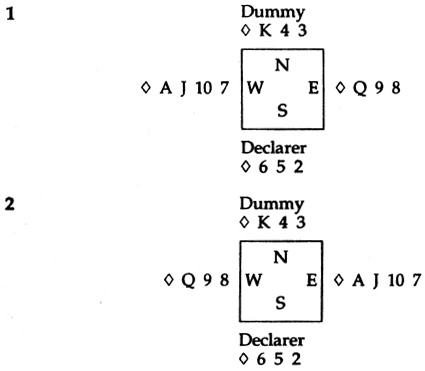
If the  A is held by West, as in the first layout, your finesse will be successful. Play a small card from your hand. If West plays the
A is held by West, as in the first layout, your finesse will be successful. Play a small card from your hand. If West plays the  A, your
A, your  K will be good on the next round of the suit. If West does not play the
K will be good on the next round of the suit. If West does not play the  A, your
A, your  K will win the trick on this round. On the other hand, in the second layout, when you play a small card, West plays a small card, you play your
K will win the trick on this round. On the other hand, in the second layout, when you play a small card, West plays a small card, you play your  K and East’s
K and East’s  A wins the trick.
A wins the trick.
You are hoping that the missing ace will be in the position it is in the first example, with West. Isn’t a 50 per cent chance of winning better than nothing? After all, if you were to lead the king, you are guaranteed to get no tricks in the suit.
Finessing against the king
By using the idea of the finesse, you can sometimes hope to take a trick with a queen when the opponents have the king. Consider this example:

Does this suit look familiar? It is the spade suit from the very first example hand in the book. We saw then that we have a sure trick with the  A, but sometimes we need also to take a trick with the
A, but sometimes we need also to take a trick with the  Q. The general concept is that you lead towards the card you hope will win a trick – you can only hope, because you know that the opponents have the king. It is interesting that, when you were promoting winners, you were not concerned with the number of cards held by either opponent. When you were developing tricks with the small cards in your long suits, you were concerned with the division of the opponents’ cards. This time you are interested in the location of the opponents’ king. There are two possibilities. It is either held by East or West. Let’s suppose West has it:
Q. The general concept is that you lead towards the card you hope will win a trick – you can only hope, because you know that the opponents have the king. It is interesting that, when you were promoting winners, you were not concerned with the number of cards held by either opponent. When you were developing tricks with the small cards in your long suits, you were concerned with the division of the opponents’ cards. This time you are interested in the location of the opponents’ king. There are two possibilities. It is either held by East or West. Let’s suppose West has it:

Play a small card toward the ace-queen combination in the dummy. If West plays the  K, take it with your
K, take it with your  A and the
A and the  Q is a winner on the next trick. If West plays small, finesse the
Q is a winner on the next trick. If West plays small, finesse the  Q and it wins the trick. Of course, if East held the
Q and it wins the trick. Of course, if East held the  K, you would not be successful in winning a trick with the
K, you would not be successful in winning a trick with the  Q. A finesse like this is only successful half of the time.
Q. A finesse like this is only successful half of the time.
The ace and queen do not have to be on the same side of the table:

You still hope the  Q will win a trick, so lead from the dummy towards the
Q will win a trick, so lead from the dummy towards the  Q in your hand. You are hoping that this is the layout of the opponents’ cards:
Q in your hand. You are hoping that this is the layout of the opponents’ cards:
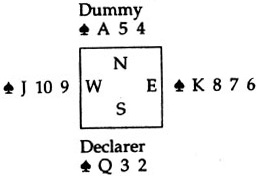
Now, if East plays the  K when you play small from the dummy, your
K when you play small from the dummy, your  Q is good on the next trick. If East plays low, your
Q is good on the next trick. If East plays low, your  Q will win this trick.
Q will win this trick.
Leading the high card
There are times when you play a high card in the process of taking a finesse. Look at this example:

The opponents have the  K, a higher card than the
K, a higher card than the  Q, and yet you are hoping to finesse successfully against the
Q, and yet you are hoping to finesse successfully against the  K and take a trick with the
K and take a trick with the  Q. You would also like to take a trick with the
Q. You would also like to take a trick with the  J or
J or  10, making a total of three tricks in this suit. You want to prevent the opponents from winning a trick with their
10, making a total of three tricks in this suit. You want to prevent the opponents from winning a trick with their  K while you get your three tricks. The objective is to try to trap the opponents’
K while you get your three tricks. The objective is to try to trap the opponents’  K. If that is your aim, let’s consider how you would go about accomplishing it. Here is the entire layout you are hoping for:
K. If that is your aim, let’s consider how you would go about accomplishing it. Here is the entire layout you are hoping for:
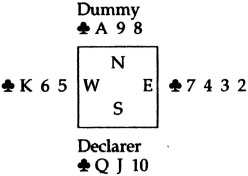
In the previous examples, if you wanted to take a trick with a card when the opponents held a higher card, you played towards the card you hoped would take a trick. In this case, to trap the opponent’s  K, you must lead one of your high cards. In order to distinguish when you can and when you cannot play a high card, ask yourself this question: how would I feel if the next opponent covered with a higher card? In the above example, play the
K, you must lead one of your high cards. In order to distinguish when you can and when you cannot play a high card, ask yourself this question: how would I feel if the next opponent covered with a higher card? In the above example, play the  Q from your hand. How would you feel if West played the
Q from your hand. How would you feel if West played the  K? That would be fine. You would take it with the
K? That would be fine. You would take it with the  A and now your
A and now your  J and
J and  10 have been promoted into winners. If West did not cover your
10 have been promoted into winners. If West did not cover your  Q with the
Q with the  K, you would next lead the
K, you would next lead the  J. Eventually, you would get three tricks in the suit, without losing any.
J. Eventually, you would get three tricks in the suit, without losing any.
Do not confuse the example above with this situation.

Suppose you were to play the  Q and the opponent on your left covered with the
Q and the opponent on your left covered with the  K. You could take the trick with the
K. You could take the trick with the  A, but you would be no better off than if you had simply played the
A, but you would be no better off than if you had simply played the  A and put the
A and put the  Q on the trick. You have promoted no extra winners, as you did in the previous example where you also held the
Q on the trick. You have promoted no extra winners, as you did in the previous example where you also held the  J and
J and  10. By playing the
10. By playing the  Q, you have given up a trick regardless of where the
Q, you have given up a trick regardless of where the  K is located. If East rather than West has the
K is located. If East rather than West has the  K, then he will take the trick with it when it is his turn to play. Either way, you do not get a trick with the
K, then he will take the trick with it when it is his turn to play. Either way, you do not get a trick with the  Q. Instead, play a small card from dummy towards the
Q. Instead, play a small card from dummy towards the  Q. If the cards are located like this, your finesse will have been successful:
Q. If the cards are located like this, your finesse will have been successful:
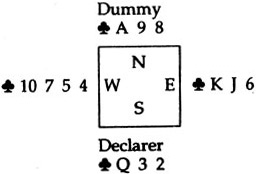
If East plays the  K, then your
K, then your  Q is a winner on the next round. If East does not play the
Q is a winner on the next round. If East does not play the  K, then your
K, then your  Q wins the first trick.
Q wins the first trick.
How can you decide when to play towards the high card you would like to win a trick and when to lead the high card? Look to the next trick. Ask yourself what will happen if your opponent covers your high card. Will you have gained anything? When you had the queen, jack and ten, you would gain something if the queen were covered. You would have promoted two winners, one with the jack and one with the ten. In the second example, where you have nothing to promote, you would gain nothing by leading the queen and would, in fact, have given up a chance to take a trick with it, since by leading towards it, you might have executed a successful finesse against the king.
Finessing against the queen
There are times when you want to take a trick with the jack when the opponents have the queen.

The idea is the same. Lead towards the card you hope will take a trick, the  J. Notice that you already have two sure tricks in the suit, the
J. Notice that you already have two sure tricks in the suit, the  A and
A and  K. You hope that the layout of the opponents’ cards is like this:
K. You hope that the layout of the opponents’ cards is like this:

Both of the high honours, the ace and king, do not need to be on the same side of the table. For example, the layout could be like this:

Now you are hoping that East holds the  Q. You would lead small from the dummy towards the
Q. You would lead small from the dummy towards the  J in your hand; towards the card you hope will take a trick.
J in your hand; towards the card you hope will take a trick.
Repeating a finesse
There are times when you have more than one card you hope will take a trick. Consider this layout:

You might need to get two tricks from this suit, hoping to take tricks with both the  K and
K and  Q. Lead towards the card or, in this case, cards which you hope will take tricks. The cards may be divided like this:
Q. Lead towards the card or, in this case, cards which you hope will take tricks. The cards may be divided like this:
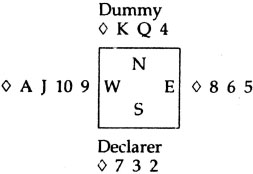
Lead towards your king-queen combination in the dummy. If West plays the  A, your
A, your  K and
K and  Q will be winners on the next two tricks. If West plays low, you can win the first trick with one of your high cards and repeat the finesse against the ace. To do this, you would have to come back to your hand with a high card in another suit and then again lead low towards the honour you have left in the dummy. For example, suppose you played the
Q will be winners on the next two tricks. If West plays low, you can win the first trick with one of your high cards and repeat the finesse against the ace. To do this, you would have to come back to your hand with a high card in another suit and then again lead low towards the honour you have left in the dummy. For example, suppose you played the  K on the first trick. This is what is left in the suit:
K on the first trick. This is what is left in the suit:
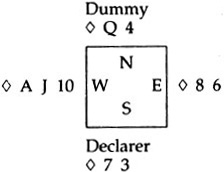
Come back to your hand and lead another low card towards the  Q. If West plays the
Q. If West plays the  A, your
A, your  Q is good on the next trick. If West plays low, your
Q is good on the next trick. If West plays low, your  Q will win this trick.
Q will win this trick.
Putting it into practice
What opportunities for the finesse do you see in the following hand? The final contract is 3NT and the opening lead is  2.
2.
Contract: 3NT
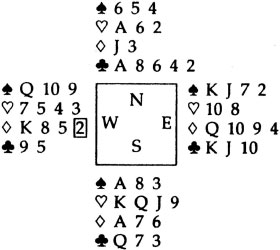
Your goal is to take nine tricks. There is one sure spade trick, four hearts, one diamond and one club for a total of seven winners. Two more need to be developed. The opening lead is a diamond and you have the  A in your hand and
A in your hand and  J in the dummy. You would like to win a trick with the
J in the dummy. You would like to win a trick with the  J but when you are missing both the king and the queen this is unlikely. Is there any possibility to develop extra tricks by finessing? Look at the clubs. You could hope to take a trick with the
J but when you are missing both the king and the queen this is unlikely. Is there any possibility to develop extra tricks by finessing? Look at the clubs. You could hope to take a trick with the  Q by leading from the dummy toward your hand. Since you can see the opponents’ cards, you can see that this is successful. You can develop one extra trick by finessing against the
Q by leading from the dummy toward your hand. Since you can see the opponents’ cards, you can see that this is successful. You can develop one extra trick by finessing against the  K.
K.
The other extra trick can be developed through the length in the club suit This is what we talked about in the last chapter. You expect the opponents’ five clubs to be divided 3–2. After you have played the suit three times, then, you have established two winners in the dummy. You still need to be able to get to your winners and the  A can be used as the entry you need.
A can be used as the entry you need.
Having organized your plan, it is time to put it into operation. After you win a trick with the  A, lead a small club to the
A, lead a small club to the  A in the dummy and then play a club from dummy towards the
A in the dummy and then play a club from dummy towards the  Q in your hand. Suppose East plays low and you win the trick with the
Q in your hand. Suppose East plays low and you win the trick with the  Q. You have played the suit twice and won the first two tricks. Lead the suit again, giving East a trick with his
Q. You have played the suit twice and won the first two tricks. Lead the suit again, giving East a trick with his  K and establishing your remaining two small clubs in the dummy as winners. The opponents can now take the three diamond tricks they have established but, when you regain the lead there are enough winners to make the contract.
K and establishing your remaining two small clubs in the dummy as winners. The opponents can now take the three diamond tricks they have established but, when you regain the lead there are enough winners to make the contract.
Summary
• A finesse is an attempt to win a trick with a card when the opponents hold a higher card in the suit. In order to do this, you usually lead towards the card you believe could win the trick. You will be successful in your efforts about half of the time.
• There are times when you have sufficient strength in the suit to plan to lead one of your high cards towards a higher card in the other hand in an attempt to trap one of the opponents’ intervening high cards. You can tell whether or not leading the high card is a good idea by imagining how you would feel if your high card was covered by an opponent’s higher card. If you don’t mind, then go ahead and play the high card. If you can see that you have sacrificed a trick by playing a high card then the better idea would be to lead towards it.
• There are times when you need to repeat a finesse, leading twice or more towards the cards which you hope will take tricks.
Over Zia’s shoulder
Hand 1 Dealer: East
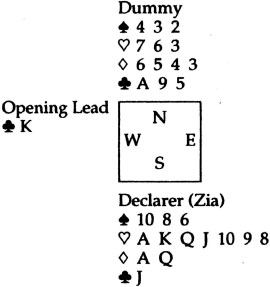
|
N |
E |
S |
W |
|
Pass |
2 |
Pass |
|
|
2NT |
Pass |
3 |
Pass |
|
4 |
Pass |
Pass |
Pass |
I can open with a strong bid at the two level to show about eight playing tricks. This has encouraged my partner to bid on to a game with his ace and three-card trump support. I hope we can make the contract. Let’s plan it together.
Solution to Hand 1:
Contract: 4
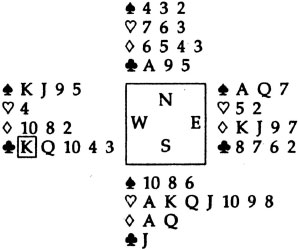
|
S |
Our goal is to take ten tricks. |
|
T |
We have seven heart tricks to go with the |
|
O |
The best chance for the extra trick we need is the diamond suit. If East has the |
|
P |
It looks normal to win the |
This is the kind of hand where we have to delay taking our trumps and try the finesse immediately, when we are in the dummy after winning the first trick. We use this opportunity to lead a small diamond and, when East plays a small diamond, play the  Q. As you can see in the full layout, this works and we chalk up another game.
Q. As you can see in the full layout, this works and we chalk up another game.
Hand 2 Dealer: South
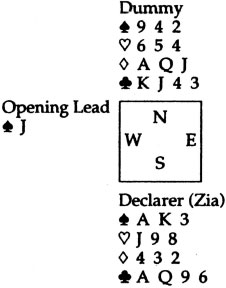
|
N |
E |
S |
W |
|
1NT |
Pass |
||
|
2NT |
Pass |
3NT |
Pass |
|
Pass |
Pass |
For once West has not attacked our main weakness, the heart suit, but I am superstitious about feeling happy about anything until the hand is over. Let’s make our plan.
Solution to Hand 2:
Contract: 3NT

|
S |
We need to take nine tricks. |
|
T |
Our sure trick count brings us to seven top tricks: two spades, one diamond and four clubs. |
|
O |
The diamond holding looks really tempting and should be good for an extra trick or two. We can see that if West has the |
|
P |
We win the opening lead with our |
Hand 3 Dealer: East
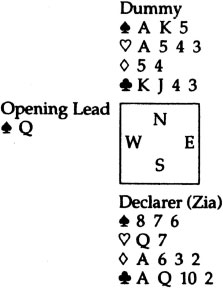
|
N |
E |
S |
W |
|
Pass |
1NT |
Pass |
|
|
3NT |
Pass |
Pass |
Pass |
My reputation in the bridge world for overbidding is well known, and in real life I get into a lot of dicey contracts.
Solution to Hand 3:
Contract: 3NT
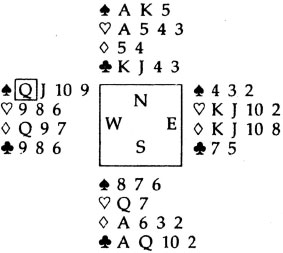
|
S |
We need nine tricks to make 3NT. |
|
T |
We have eight winners: two spades, one heart, one diamond and four clubs. Only one more trick needs to be developed. |
|
O |
There is a finesse against the |
|
P |
So here goes. We win the first trick in dummy and lead a small heart. Whether East plays his |